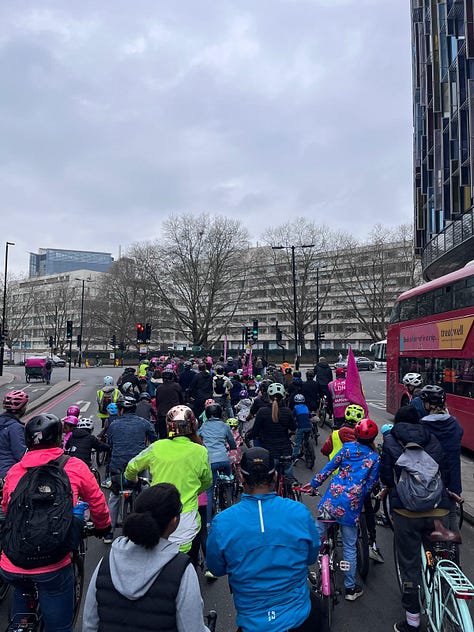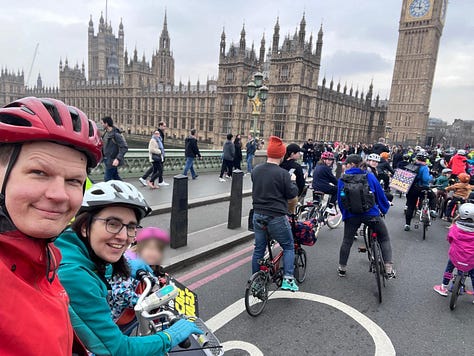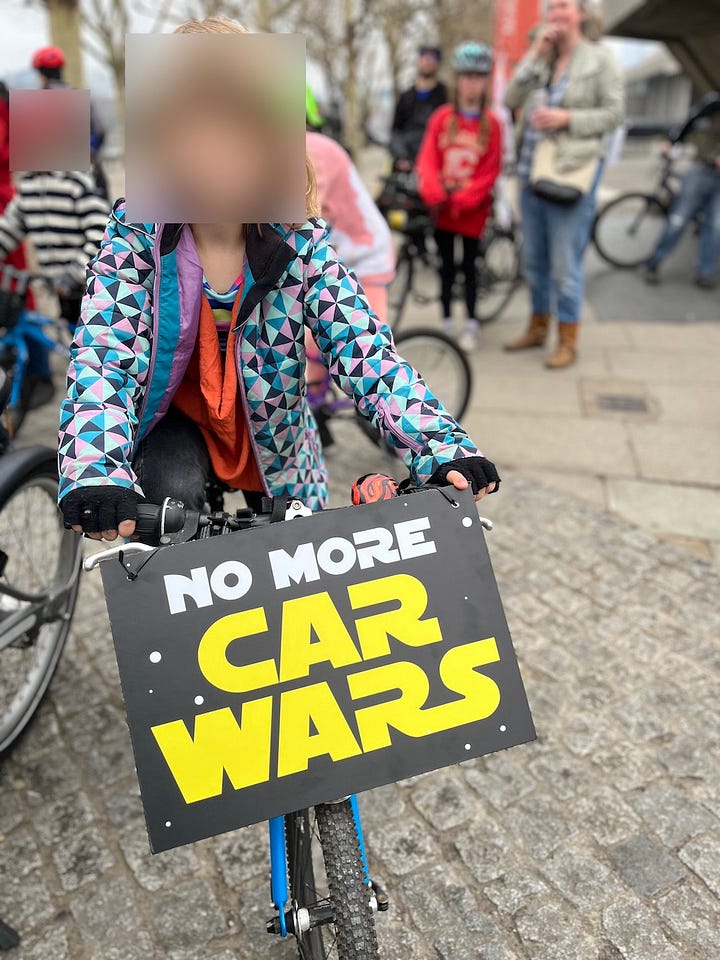Last weekend we joined Kiddical Mass in central London. This was a ride of 200+ adults and children (we reckon the children outnumbered the adults) taking in the South Bank, Parliament, the Mall, Covent Garden, Exmouth Market and the Brunswick Centre. The ride took about 1.5 hours to complete at a leisurely four miles per hour!





The message for the ride was about car-spreading or autobesity. At the start of the ride we were told that car widths are growing by 1cm every two years. This same research shows that half of new cars in Europe are too wide for many parking spaces.
While the main focus was about safety (heavier cars, harder to see around when crossing), there is also an air pollution impact. Bigger cars emit more particulate matter pollution, consume more fuel, plus the indirect effect of discouraging cycling and other active travel.
What can we do?
Clean Cities Campaign have a set of actions they are calling for to address this, including regulation, tax, advertising bans and higher parking charges. Paris famously introduced the latter around six months ago, which has already reduced the rate of such cars being parked on streets in the city by two thirds. The Campaign is also asking people to share images of #carspreading and mentioning @cities_clean on X, @cleancitiescampaign on Instagram or @cleancitiescampaign.org on BlueSky.
In the last month we have noticed some enormous cars being parked in the streets around us, making the typical SUV parked next to it look miniscule. There is already a collection of photos showing how these vehicles dwarf children trying to get to school or cross roads. We heard at the event that Lambeth Council (via deputy leader, Rezina Chowdhury) will be launching a call for evidence on SUVs as part of the Kerbside Strategy - we’ll update once we see it.
Back to the ride…
The roads weren’t closed and instead the event was marshalled (hats off to the marshals - a difficult job) so that traffic coming in from side roads was held and the whole ride could proceed as a convoy. As an aside, most onlookers and fellow road users were cheering the sight of hundreds of children cycling in central London (with upbeat musical accompaniment). However, are few got cross at being asked to pause their journeys including one taxi driver being heard to say “I don’t care if it’s kids” (or even stronger words…)
Hence the ride took place in broadly typical central London traffic. Unfortunately this meant pretty high pollution. Pollution levels have been concerning a few times through the winter (we will do a round up on this soon). On this occasion, the nitrogen dioxide was over 40 micrograms per cubic metre, and the particulate matter over 30. Not something we would want small children subject to on a regular basis…




I’d like to comment on the issue of car widths and parking space dimensions. In the UK, there’s no legal standard for parking space size—only recommendations. The Institution of Structural Engineers (IStructE) seems to provide the most widely accepted guidance, suggesting spaces should be 2.6 metres wide and 5.0 metres long.
However, a new standard appears to be emerging for EV parking spaces, setting the width at 2.8 metres—regardless of the vehicle's size. Across Europe, space widths vary between 2.3 and 2.6 metres, depending on the country.
Personally, I’d love to own a 1957 Fiat 500—only 1.627 metres wide—but after being driven in one with two others over six feet tall, I can confirm it wasn’t exactly practical. Perhaps this is part of the reason cars have grown in size over the years.
Even my compact EV, which can barely seat four (comfortably two), measures 1.775 metres wide—and it still struggles to fit into ‘modern’ parking spaces in most car parks. Opening the doors is a challenge, even in relatively empty bays.
Perhaps the real campaign should be for decently sized parking spaces that allow everyone—whether able-bodied or infirm—to get in and out of their car without difficulty.
And while we're at it, why is Lambeth Council wasting public money on yet another consultation about SUVs and kerbside parking? They often tell us that fewer than 25% of their residents own a car, yet on my street, there's so much kerbside parking that I could park a bus and still have room for every resident's vehicle.
…And is the air pollution referenced in the article truly coming from vehicles—or is it actually from buildings? I suspect that one day, when the cars are gone, we’ll realise the pollution levels haven’t improved much at all.
What we need is real data that clearly shows how and where pollution is being generated. My hunch is that a significant share comes from gas-fired boilers working overtime to heat poorly insulated homes and commercial properties.
How many businesses, for instance, have proper double glazing—or even a policy to keep their doors closed in cold weather?